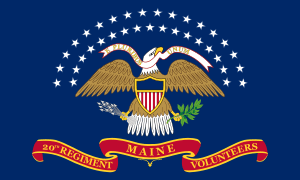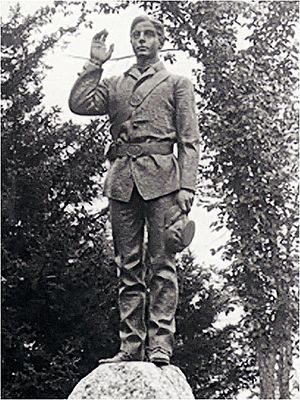Maine in the American Civil War facts for kids
Maine was a strong supporter of ending slavery and the Republican Party. Because of this, Maine sent more of its citizens to fight for the Union armies than any other state. It also provided a lot of important equipment and supplies. Even though no big land battles happened in Maine, there was a small fight called the Battle of Portland Harbor in 1863. During this battle, a group from the South tried to capture a government ship but failed.
Abraham Lincoln chose Hannibal Hamlin from Maine to be his first Vice President. A brave soldier named Joshua L. Chamberlain and his 20th Maine Volunteer Infantry Regiment played a very important part in the Battle of Gettysburg. Also, the 1st Maine Heavy Artillery Regiment lost more soldiers in one attack during the siege of Petersburg than any other Union regiment in the entire war.
Contents
Maine's Role in the Civil War
Maine was very enthusiastic about helping the Union. It sent more people to fight, compared to its population, than any other Union state. About 80,000 men from Maine joined the U.S. military as soldiers and sailors. They were organized into 32 infantry (foot soldier) regiments, two cavalry (horseback soldier) regiments, seven light artillery groups, and one heavy artillery regiment.
Hundreds of regular citizens also helped. They worked as nurses, doctors, and relief workers both at home and near the battlefields. Many joined groups like the United States Sanitary Commission or the United States Christian Commission. These groups helped care for wounded soldiers and provided supplies.
One Union soldier from Maine, Walter Stone Poor, wrote in a letter that he fought to end slavery. He believed it was a noble cause and was willing to give his life for it. He felt that ending slavery was even more important than the American Revolution, which was fought for freedom.
How Maine Helped the Union
During the early years of the war, several groups that wanted to end slavery kept the issue in the public eye. Newspapers in Maine kept people informed about the war's progress and results. Factories in Maine made ships, naval supplies, army equipment, and tents.
Thomas Lincoln Casey was in charge of protecting Maine's coast. He oversaw forts like Fort McClary and Fort Preble. He also finished building the very large Fort Knox on the Penobscot River.
No major land battles of the Civil War were fought in Maine. However, in June 1863, Southern raiders tried to capture a government ship in Portland. This event, known as the Battle of Portland Harbor, made people in Maine even more determined to fight against the Confederacy.
Important Leaders from Maine
Political Leaders
Hannibal Hamlin from Paris, Maine, was Vice President under President Lincoln for his first term. He was a great speaker and strongly against slavery. He encouraged Lincoln to issue the Emancipation Proclamation, which declared many enslaved people free. He also pushed for African Americans to be allowed to join the army. Because of his strong views, he was not chosen to be Vice President again in 1864.
Augusta newspaperman and U.S. Congressman James G. Blaine was a powerful voice in Congress. He played a big role in politics after the war during the Reconstruction period. He helped create the Fourteenth Amendment to the United States Constitution, which gave citizenship and equal rights to African Americans. Later, he ran for President in 1884.
Army Generals
More than 25 men from Maine became generals in the Union army. Many others led brigades (smaller army units) as colonels. The highest-ranking officer was Major General Oliver O. Howard from Leeds. He commanded the XI Corps in several big battles, including Chancellorsville and Gettysburg. He lost an arm in the Battle of Seven Pines in 1862.
In late 1863, Howard and his corps moved to the Western Theater of the war. They joined the Army of the Cumberland in Tennessee. In the Battle of Chattanooga, Howard's corps helped capture Missionary Ridge. This forced Confederate General Braxton Bragg to retreat. In July 1864, Howard became the commander of the Army of the Tennessee. He fought in the Atlanta Campaign. He also led the right side of Major General William T. Sherman's army during the famous Sherman's March to the Sea and the later Carolinas Campaign.
Other important generals from Maine included George Lafayette Beal of Norway. He led a brigade in the Red River Campaign and the Valley Campaigns of 1864. He was promoted to general for his brave service at the Battle of Cedar Creek. There, his brigade broke through the Confederate lines and changed the course of the battle.
Hiram Berry of Rockland was killed at Chancellorsville while leading his division in a bayonet charge. James G. Blunt, an abolitionist born in Trenton, won a victory at the Battle of Honey Springs. This battle brought much of the Indian Territory under Union control. In 1864, Blunt's division defeated Sterling Price at the Second Battle of Newtonia. This ended Price's Missouri Raid.
Hiram Burnham of Narraguagus was killed attacking Confederate positions near Richmond, Virginia, during the Battle of Chaffin's Farm. Lowell's John C. Caldwell led a division at Gettysburg in the fighting in the Wheatfield. Aaron S. Daggett of Greene was the last Union Civil War general to pass away. He died in 1938 at 100 years old. Neal Dow of Portland led a brigade during the capture of New Orleans and later commanded the District of Florida.
Brothers Francis and James Fessenden were both generals. They came from a well-known political family in Maine. Cuvier Grover of Bethel commanded a division during the capture of Baton Rouge and the siege of Port Hudson. Hampden's Cyrus Hamlin led a brigade of black troops at Port Hudson. Albion P. Howe of Standish commanded a division at Fredericksburg, Chancellorsville, and Gettysburg. Rufus Ingalls of Denmark, Maine, was the main supply officer for the Army of the Potomac. He later managed supplies for all armies fighting near Richmond and Petersburg. He built a huge supply base at City Point, Virginia.
Erasmus D. Keyes of Kennebec County commanded the IV Corps for the first half of the war. Augusta's Seth Williams was a top assistant to the general of the Army of the Potomac. Later, he worked for Ulysses S. Grant. At Appomattox Court House in April 1865, he delivered Grant's message to Robert E. Lee offering to accept his surrender. He then gave Grant's terms to the Confederate Army of Northern Virginia.
Danville Leadbetter, born in Leeds, chose to fight for the Confederacy and became a general in their army.
James Alden Jr. of Portland commanded the steamship USS Brooklyn. He fought against Fort Gaines, Fort Morgan, and Confederate gunboats in the Battle of Mobile Bay. Henry K. Thatcher of Thomaston commanded the West Gulf Blockading Squadron. He led a combined army and navy attack against Mobile, which surrendered on April 12, 1865.



